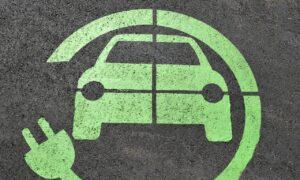The EV market is ‘a pretty brutal space,’ Mercedes CFO Harald Wilhelm said.
As the Biden administration hails America’s “historic transition to electric vehicles” over the next decade, and carmakers pledge that they are revamping their production lines for an electric future, one group has been left out of the conversation thus far—consumers.
Now consumers are having their say.
With battery electric vehicles (EVs) sitting unsold on dealer lots, carmakers are slashing prices in a desperate attempt to move them, and suffering billions in losses along the way.
“It’s always been the ‘build it and they will come’ strategy,” Vince Sheehy, a Washington car dealer said in an interview with Business Insider. “And they’re just not coming.”
In its earnings report released last week, Ford announced that its EV division posted a quarterly loss of $1.33 billion, on top of a $1.08 billion loss in the previous quarter. In response, Ford said that it would halt production of the electric Mustang Mach-E and cut back its planned $12 billion investment in new EV production, including delaying the opening of a battery plant in Kentucky.
Similarly, GM announced a $1.5 billion hit to profits this quarter, due in part to EV losses. GM CEO Mary Barra, who had formerly claimed that her company’s future was fully electric,
announced that GM would drop its production targets of 500,000 EVs over the next 12 months, saying the transition to EVs would be “a bit bumpy.”
On Oct. 17, GM said it would
delay all-electric truck production at its Michigan plant until late 2025.
Despite this, many auto analysts continue to predict that the days of the internal combustion engine (ICE) car are numbered, and that an electric future is inevitable.
JATO, an auto analytics firm, states that “while consumer demand for ICE vehicles will persist in the short term, production will be phased out as [carmakers] accelerate their electrification plans.”
A Bad Bet for Carmakers?
However, even with government pressure and analysts’ certainty that EVs are the future, carmakers may be starting to wonder if they are making a dangerous gamble by rushing into a market where there may not be sufficient demand, or in which they cannot compete with cheaper EVs made in China.Mercedes CFO Harald Wilhelm summed up the sentiment of many western auto companies,
stating on a call with industry analysts on Oct. 26 that the EV market is “a pretty brutal space. I can hardly imagine the current status quo is fully sustainable.”
Mercedes is reportedly discounting virtually its entire line of EVs.
Economist Stephen Moore said in a
Fox News interview that EVs may be carmakers’ “next big flop,” comparing them to Ford’s disastrous bet on the “Edsel” model in the 1950s.
“Car buyers don’t want them,” Mr. Moore said.
In a
February poll conducted by the Energy Policy Institute at the University of Chicago, only 19 percent of respondents said it was “very” or “extremely” likely they would purchase an EV. About half of respondents said they would not buy an EV, and consumers typically cite the high cost, limited range, and worries about not being able to charge them as their main concerns.
Akio Toyoda, Chairman of Toyota, which has for some time been skeptical of all-electric vehicles,
told attendees at the Japan Mobility Show on Oct. 25 that “people are finally seeing reality” on EVs.
Toyota has been a pioneer in hybrid technology and is also developing hydrogen-powered cars. Standing as one of the few holdouts among carmakers, Toyota has stated that, rather than attempting to force EVs on the market, consumers should be able to decide what type of cars they want.
Honda CEO Toshihiro Mibe announced on Oct. 25 that his company was canceling a project with GM to develop EVs under $30,000.
“After studying this for a year, we decided that this would be difficult as a business,” Mr. Mibe
said. “So at the moment we are ending development of an affordable EV.”
Several weeks ago, Ford said it was planning to
reduce the production of its F-150 lightning electric pickup truck, saying that it would renew its focus on hybrids.
Meanwhile, EV startup companies are
falling from grace on Wall Street, with once heralded companies like Rivian, Lordstown, Volta, and Lucid now going under or missing financial targets.
China Has the Competitive Advantage
If western automakers are indeed betting on an all-electric future, they are entering this market with numerous disadvantages compared to rising carmakers in China. According to JATO’s analysts, China has matched western automakers in EV quality and is producing them at a much lower cost.
“The average retail price of an electric car available in China is now less than half the price seen in both Europe and the USA,”
said Felipe Munoz, global analyst at JATO Dynamics. And where western automakers have concentrated on the premium segments of the market, catering to the wealthy, China has focused on making affordable EVs, with 78 percent of Chinese-made EVs under $43,500 and one-third priced below $21,700.
Furthermore, while American consumers currently pay 146 percent more for the cheapest EV compared to the cheapest combustion car, in China the cheapest EV is 8 percent less than the cheapest combustion car. China is thus gaining the benefits of scale, with domestic EV sales topping 25 million units.
The pricing strategy of Chinese carmakers allows them not only to dominate the domestic market but also to gain the upper hand in developing countries. Chinese vehicles are now the majority of EV’s sold in Israel, Russia, and Thailand, and more than a quarter of EVs sold in Brazil, Malaysia, Mexico, the Philippines, Chile, and Indonesia, according to JATO vice president
Samir Sawalhi.
China is also making inroads into Saudi Arabia, Australia, and New Zealand.
While some analysts say that Chinese carmakers are not burdened by the cost of “stranded assets” of ICE manufacturing infrastructure, profits from combustion vehicles are currently what is keeping many carmakers afloat.
“The ICE business really funds the EV business,” former Ford CEO Mark Fields
said in a CNBC interview last week. “You’ve got to keep that golden goose producing for them.”
Not only does China have significantly lower labor costs, it also powers its industry with cheap and reliable coal plants. Perhaps even more critically, it dominates much of the supply chain for the raw materials of EV batteries.
China, for example, controls
67 percent of the refining of lithium, one of the materials required to make EV batteries. And China can curtail the supply to western carmakers, as demonstrated by its recent action to
restrict exports of graphite.
Chinese authorities appears to be deeply committed to growing its national auto industry, and EVs are proving to be the ideal entry point.
“The rapid progress made by China to produce competitively priced EVs that rival the rest of the world on both technology and model-type comes is part of its economic growth ambitions,” Mr. Munoz states. “With the growth of the Chinese economy showing signs of a slowdown, its electric car industry has become increasingly important in supporting the economy with green jobs and technological innovation.”
Biden Attempts to Copy China’s Auto Industrial Policy
The United States is attempting to duplicate China’s strategy, with hundreds of billions in federal spending and subsidies now dedicated toward remaking America’s automotive industry via central planning.The White House
announced on April 17 that “as part of President [Joe] Biden’s goal of having 50 percent of all new vehicle sales be electric by 2030, the White House is announcing public and private commitments to support America’s historic transition to electric vehicles (EV) under the EV Acceleration Challenge.”
“Because of President Biden’s leadership and historic investments, electric vehicle sales have tripled and the number of publicly available charging ports has grown by over 40 percent since he took office,” the White House stated. “There are now more than three million EVs on the road and over 135,000 public EV chargers across the country.”
Ostensibly, the goal of reorienting western carmakers away from ICE vehicles and hybrids, where they have a competitive advantage from brand recognition, supply chains, and many decades of engineering expertise, toward EVs, where they are at a disadvantage to China, is all for the goal of reducing CO2 emissions. Oddly, however, the EPA regulations that are designed to force automakers to switch to EV production only measure emissions at the vehicle tailpipe; they do not take into account emissions from strip mining, extraction, and refining of raw materials, from the assembly of batteries, or from charging them on the electric grid once the EVs hit the road.
If these elements were taken into account, EVs often do not offer a
significantly lower-emitting alternative to ICE vehicles. According to a
study by the Massachusetts Institute of Technology’s Climate Portal, whether EVs significantly outperform ICE vehicles or hybrids over their lifetime depends to a great extent on the energy mix used to charge them.
If cars are driven in a country like Norway, which produces most of its electricity from hydro power, EVs will produce less CO2 over their lifetime. If they are driven in China, or parts of the United States that produce a majority of electricity from coal, the benefit of lower CO2 emissions disappears.
Skeptics of America’s auto industrial policy also point out that our electric grid is unlikely to be able to handle the additional demand from EVs, raising questions of whether consumers could reliably power them if they reach a significant market share.
In an
April interview with The Epoch Times, John Moura, director of reliability assessment at the North American Electricity Reliability Corp. (NERC), a national regulatory agency, said that “one electric vehicle charger is equivalent to about two-and-a-half normal-sized air conditioners.”
“Today, we don’t have the generating capacity that would be needed to serve any percentage of the total EV cars in a given area,” Mr. Moura said. “No area has the capacity to handle it today.”







